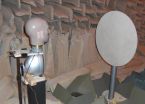(Press-News.org) The EU-funded MycoSynVac project combines gene engineering and biotechnology to design a novel veterinary vaccine chassis based on the bacterium Mycoplasma pneumoniae.
By combining their systems biology expertise with cutting-edge synthetic biology methodologies, researchers will engineer a universal chassis, which will be free of virulence and optimized for fast growth in a serum-free medium.
This chassis will be used to create specific vaccines against two highly detrimental pathogens that are causing suffering in livestock animals and large financial losses to the animal industry. The chassis will also set the basis for other potential applications, such as for cell therapy and infectious lung disease treatment.
MycoSynVac is a 8 M€ H2020 EU project coordinated by scientists at the Centre for Genomic Regulation in Barcelona (Spain) and with participation of industrial and academic partners in The Netherlands, France, UK, Germany, Denmark and Austria.
The Mycosplasma bacteria are the smallest self-replicating organisms. They lack a cell wall, making them resistant to almost all antibiotics, and infections caused by Mycoplasma in livestock?result in annual multimillion euro losses in Europe and throughout the world. Although there are vaccines against two species of Mycoplasma that affect pigs and poultry, no vaccines exist for many Mycoplasma species that affect not only livestock but also pets and humans.
The new H2020 EU project MycoSynVac aims to bio-engineer Mycoplasma pneumoniae into a universal chassis for vaccination by using cutting-edge synthetic biology methodologies. "We will engineer a new bacteria to be used as a vaccine, explains Luis Serrano, director of the Centre for Genomic Regulation (CRG) and co-coordinator of this project. "We will remove the genes that make the bacteria pathogenic and the improve the chassis for an optimized growth in a serum-free medium. By expressing specific harmless antigens from one or more pathogens, we will be able to create targeted vector vaccines. We have been working for a long time to deeply understand Mycoplasma pneumoniae and are now ready to take a step forward and use this knowledge for the benefit of society", adds Maria Lluch, staff scientist at the CRG and scientific co-coordinator of MycoSynVac. A second phase of this project includes targeting the development of attenuated (with the pathogen weaken but still alive) and/or inactivated vaccines (with killed pathogen) against M. hyopneumoniae, which infects pigs, and M. bovis, which infects cattle.
"This project pursues an ambitious challenge, and we recognize the importance of us taking into account not only its technical details but also its societal and ethical dimensions", agree both coordinators. To effectively address these highly diverse aspects, the project consortium is composed of: research groups working on gene engineering and design of biological systems at the CRG (Barcelona, Spain), the French National Institute for Agricultural Research (Bordeaux, France), the Wageningen University (Wageningen, The Netherlands), and the Imperial College (London, UK); a research group focused on the bioethical aspects the University of Copenhagen (Copenhagen, Denmark); industrial partners of MSD Animal Health (Boxmeer, The Netherlands) and ATG Biosynthetics, a biotech company working on functional bioinformatics (Merzhausen, Germany); and the risk assessment and public engagement company Biofaction (Vienna, Austria).
Improving animal health & more
No effective vaccinations exist against many mycoplasmas that infect pets, humans and livestock. Research and development has been hampered by the fact that most mycoplasmas are difficult to grow without the presence of other organisms and require a complex media that includes animal serum. Consequently, even in those cases for which effective vaccines are available, the production process of the vaccines is hardly reproducible and prone to contamination by viruses.
To meet the needs of the livestock industry, MycoSynVac will capitalize on its scientists' extensive systems biology knowledge about M. pneumoniae and on its cutting-edge synthetic biology methodologies to design a universal Mycoplasma chassis that can be deployed as single- or multi-vaccine in a range of animal hosts. Also, the engineered bacterium will grow efficiently and reproducibly in a defined serum-free medium, which will significantly improve its production, quality, and efficiency.
Researchers also foresee that the generated mycoplasma chassis can be further developed for other vaccines and will have other potential applications, such as in cell therapy and infectious lung disease therapy.
INFORMATION:
MycoSynVac, which was launched today at the Centre for Genomic Regulation (CRG) in Barcelona, is a 5-year project funded by the European Union's Horizon 2020 Research and Innovation programme under grant agreement No 634942.
TAMPA, Fla. -- Androgen deprivation therapy (ADT) is a common treatment option for patients with advanced stage prostate cancer. But nearly 80 percent of patients who receive ADT report experiencing hot flashes during and after treatment. Moffitt Cancer Center researchers are working to determine what genetic factors and other characteristics might make prostate cancer patients more likely to experience hot flashes during and after therapy.
Cancer therapies often are associated with unwanted side effects. Some side effects can be so debilitating that patients decide ...
Mexico is undergoing a transformation: ranked as the second largest economy in Latin America, it's an increasingly dynamic middle-income country -- and its population is ageing rapidly. How will this relate to the burden of cancer?
Mexico is an interesting case study for the relationship between population ageing and cancer burden, according to new research published in ecancermedicalscience.
Researchers led by Dr Ajay Aggarwal of the Institute of Cancer Policy, Kings College London, UK, examined population data, cancer databases, and the research output of Mexican ...
The ability that some people have to use echoes to determine the position of an otherwise silent object, in a similar way to bats and dolphins, requires good high-pitch hearing in both ears, according to new research from the University of Southampton.
The study, published in Hearing Research, found that locating an object by listening to echoes, without moving the head, requires good hearing at high frequencies and in both ears. This builds on research published in 2013 by the team at the University's Institute of Sound and Vibration Research (ISVR) that demonstrated ...
Scientists at LSTM have come a step closer to understanding why people exposed to household air pollution (HAP) are at higher risk of lung infections such as pneumonia and tuberculosis.
Three billion people worldwide are exposed to HAP from the fuels they burn to cook, light and heat with at home. Frequently, charcoal, wood and food waste are burned and generate high concentrations of smoke particles. This exposure is associated with increased risk of pneumonia, particularly in low and middle income countries where bacterial pneumonia is the biggest cause of infant mortality. ...
PITTSBURGH-- Countless research and self-help books claim that having more sex will lead to increased happiness, based on the common finding that those having more sex are also happier. However, there are many reasons why one might observe this positive relationship between sex and happiness. Being happy in the first place, for example, might lead someone to have more sex (what researchers call 'reverse causality'), or being healthy might result in being both happier and having more sex.
In the first study to examine the causal connection between sexual frequency and ...
This news release is available in Spanish. Metals are pollutants that have to be monitored in order to obtain a global overview of the quality of water systems, due to the fact that they remain in the environment. Although sediments act as a drain for pollutants, they can also act as a source of pollutants under certain environmental conditions (like changes in the composition of the water or movement of the sediments owing to a flood event). The UPV/EHU's Hydrology-Environment Group has conducted research on the River Deba and its tributaries to assess the influence ...
The most populated areas of Puget Sound have experienced striking shifts in marine species, with declines in herring and smelt that have long provided food for other marine life and big increases in the catch of jellyfish, which contribute far less to the food chain, according to new research that tracks species over the last 40 years.
The parallel trends of rising human population and declining forage fish such as herring and smelt indicate that human influences such as pollution and development may be eroding species that long dominated Puget Sound. In particular, the ...
Hamilton, ON (May 7, 2015) - A team of researchers based at McMaster University has developed a new understanding of post-concussion syndrome, answering questions that have been plaguing researchers in the field.
Their study, published in the medical journal Brain, Behavior and Immunity, provides an explanation for why many people with even very trivial head injuries, or even injuries to other parts of their bodies, experience incapacitating post-concussion like syndromes.
These symptoms include headaches, dizziness, cognitive impairment and other neuropsychiatric symptoms ...
Researchers have discovered a new gene that enables plants to regulate their growth in different temperatures.
Published in PLoS Genetics today, the finding could lead to new ways of optimising plant growth when it comes to climate change.
Associate Professor Sureshkumar Balasubramanian, from Monash University, along with colleagues in Spain, made the discovery after analysing natural populations of the model plant Arabidopsis thaliana, commonly known as thale cress.
"Plants are highly sensitive to environmental changes and even small changes in temperature impact ...
Danish researchers at the University of Copenhagen have discovered how to map more than one protein at a time, when proteins repair damaged DNA. It is a discovery that will help accelerate the process of developing better and gentler cancer treatments. The discovery has just been described in an article in the renowned scientific journal, Science.
When DNA is damaged, several different proteins start pouring in to repair the damage; their types depend on the damage done. Up until now, it has been common practice to study one protein at a time, but by way of so-called ...

